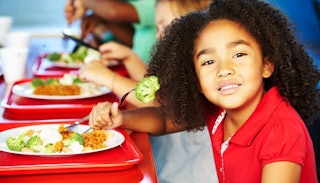Why I'm Going To Let My Kid Eat The Disgusting School Lunch

My son starts kindergarten in a couple of weeks, and I’m already wondering how to handle the cafeteria meals. As a child in public school in the ’80s, I was forbidden from ever buying the school lunch. For one, I had so many allergies that my mother despaired of finding a single menu item I could eat. For another, she thought the school lunches were unhealthy—and disgusting.
A look at the school lunch menu for our district shows that not a lot has changed: In one week, three of the options are fried burgers, fried chicken, and fried cheese. Chocolate milk—which is sweet enough to qualify as a dessert—is offered daily. But frankly, it’s not the excessive salt, sugar or animal fat that bothers me. No, it’s the sheer institutionalness of the meal. I know it’s really difficult to provide tasty, healthy meals that meet calorie and nutrition requirements, on a budget, on a large scale. I respect that schools have a tricky balancing act. But if my son has a choice between school food—which I doubt is substantially more delicious than hospital food—shouldn’t I insist that he take the packed lunch, every time?
Actually, I’m thinking no, and here’s why: Because I was not allowed to eat the public school lunch as a child, those lunches became forbidden fruit. The smell of grilled cheese and tomato soup wafting through the cinderblock and linoleum halls tormented me weekly. There was a dish called American Chop Suey—a hash of elbow macaroni, hamburger, and tomato sauce—that I still think about (and sometimes even make, to use up leftovers). My food restrictions made me crazy: I once got my hands on a carton of Twinkies, which were forbidden due to allergies, ate 17 of them, and landed in the hospital. I may the only person in America who fantasizes about the lunches she didn’t eat 30 years ago.
In my opinion, the school lunches look disgusting, but the key here is in my opinion. My son recently ate a vile hamburger and limp, mushy fries from a sketchy diner (I managed about two bites of mine, which tasted like it had been frozen and thawed 13 times on its voyage from Brazil) and declared it the best meal he’d ever had.
I want to develop my son’s palate so that he knows what “good” food is, but his palate is developing at its own pace. It’s impossible to restrict him from influence from the larger culture while he’s learning. Walling off certain foods as “disgusting” will only make them more attractive.
I’ve been following Ellyn Satter’s guidance on feeding children, a method that promotes a “division of responsibility”—the parent decides what to serve, and the child decides if and how much to eat. So I could say, perfectly legitimately, that I decide what goes in the (packed) lunch and he can decide whether to eat it or not. But I think that restricting him entirely from the school lunch is going to backfire as it did for me, creating a class of forbidden food that will be that much more tantalizing. For example, Satter recommends, once in a while, letting your child sit down to a large plate of some treat like Oreos and allowing them eat their fill without comment. Only by letting kids regulate themselves will they learn to regulate themselves.
I think this is the best strategy for the school lunches, too: We’ll look at the menu and choose or two days a week when he’d like to buy his meal rather than pack it.
We’ll do it because school lunch is the first introduction to a bigger dilemma. The larger world is full of temptations that might not be healthy or even particularly tasty. I like Satter’s approach because following it doesn’t mean you have to buck the whole culture—your kid learns how to navigate the myriad choices that everyday American life has to offer. When they’re grown, they’re going to have to deal with vending machines, fast food restaurants, and crappy hotel breakfast bars. We hope that they’ll have a good diet in general—food cooked at home, lots of fresh vegetables—but also have the flexibility to eat the occasional stale-but-still-yummy Danish at an office retreat without it being a big deal.
Who knows, he might think the school lunches are delicious, not disgusting. After all, schools are serving more nutritious offerings, like kale salad or a ginger-sesame coleslaw, than they did when I was a child. Though there’s one thing conspicuously absent from the menu: American Chop Suey.